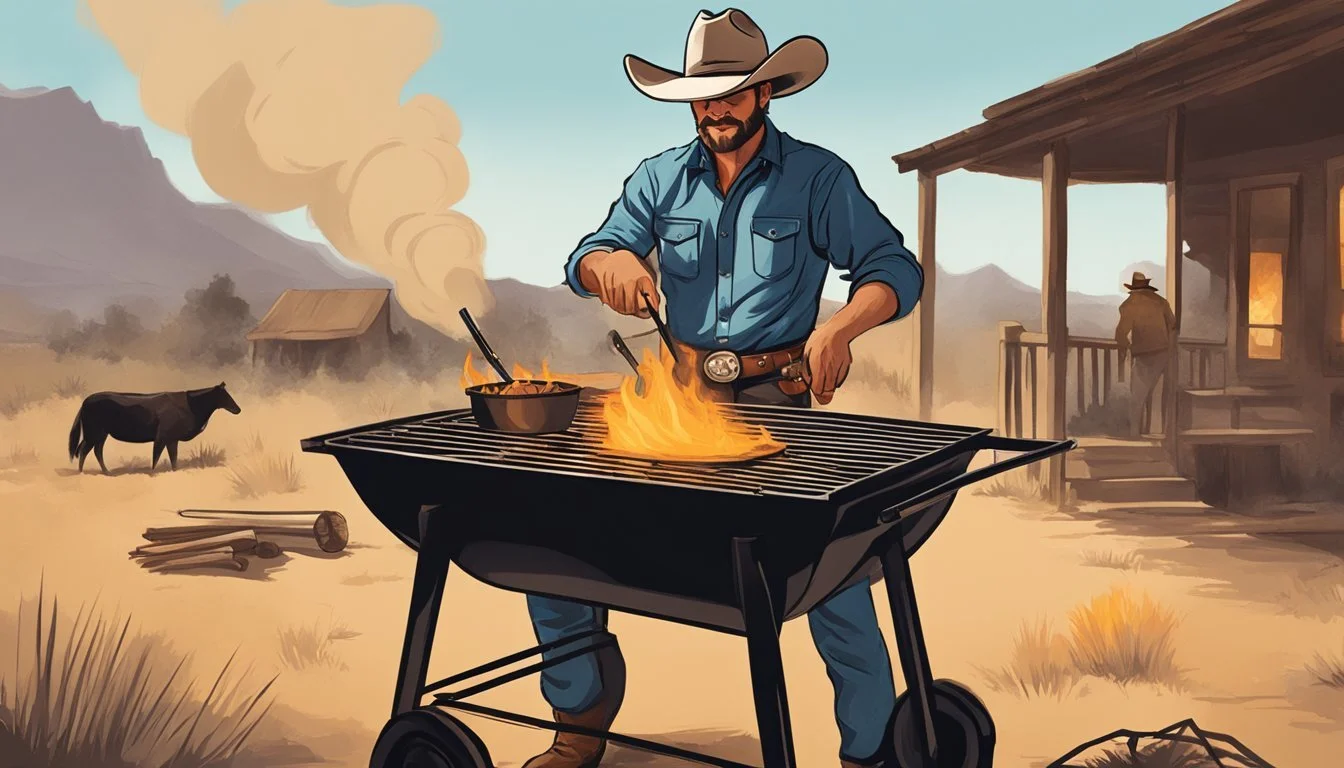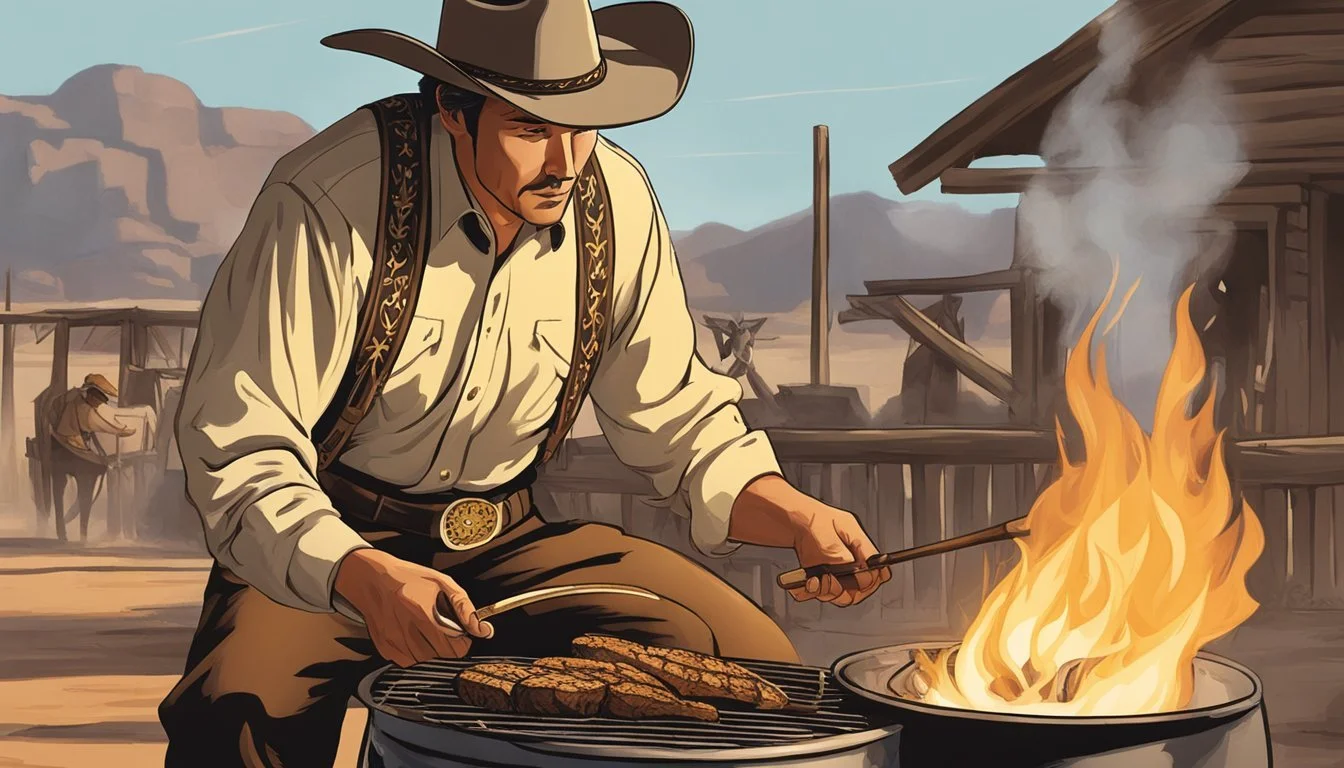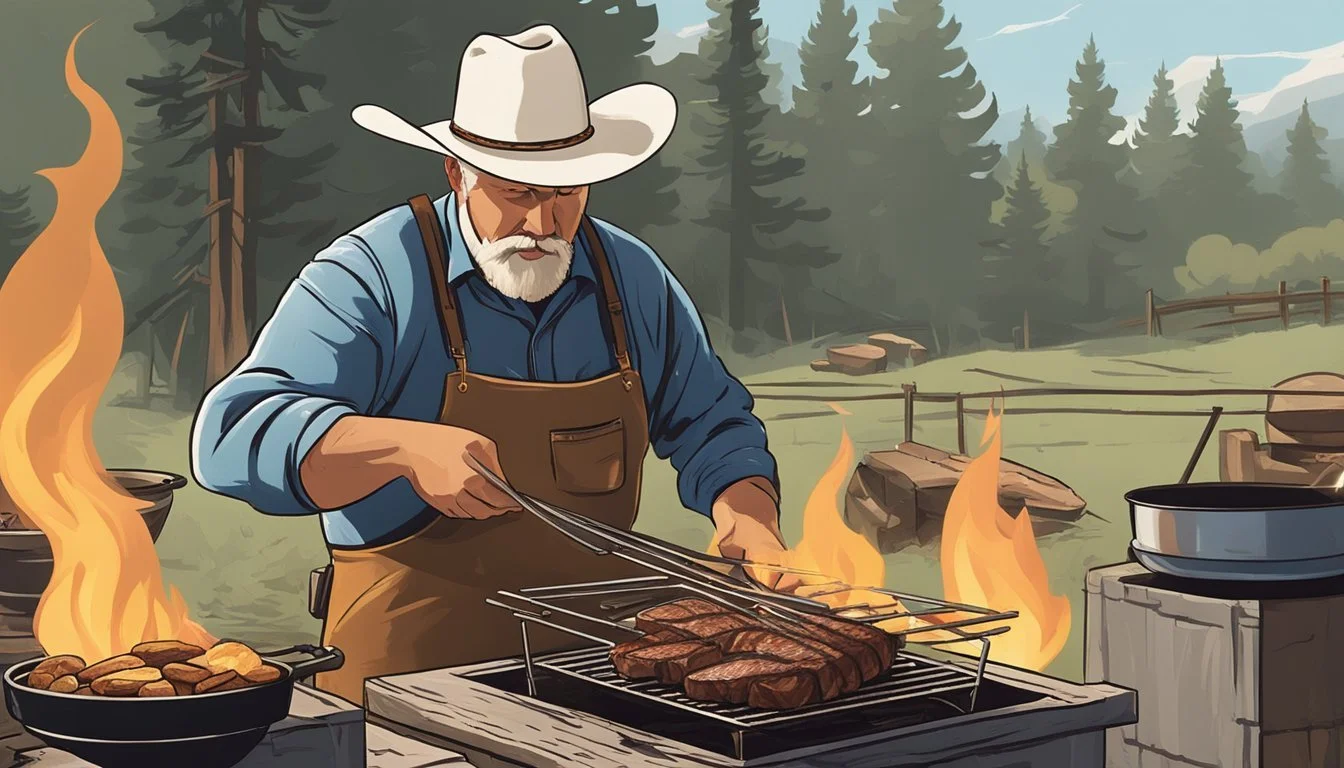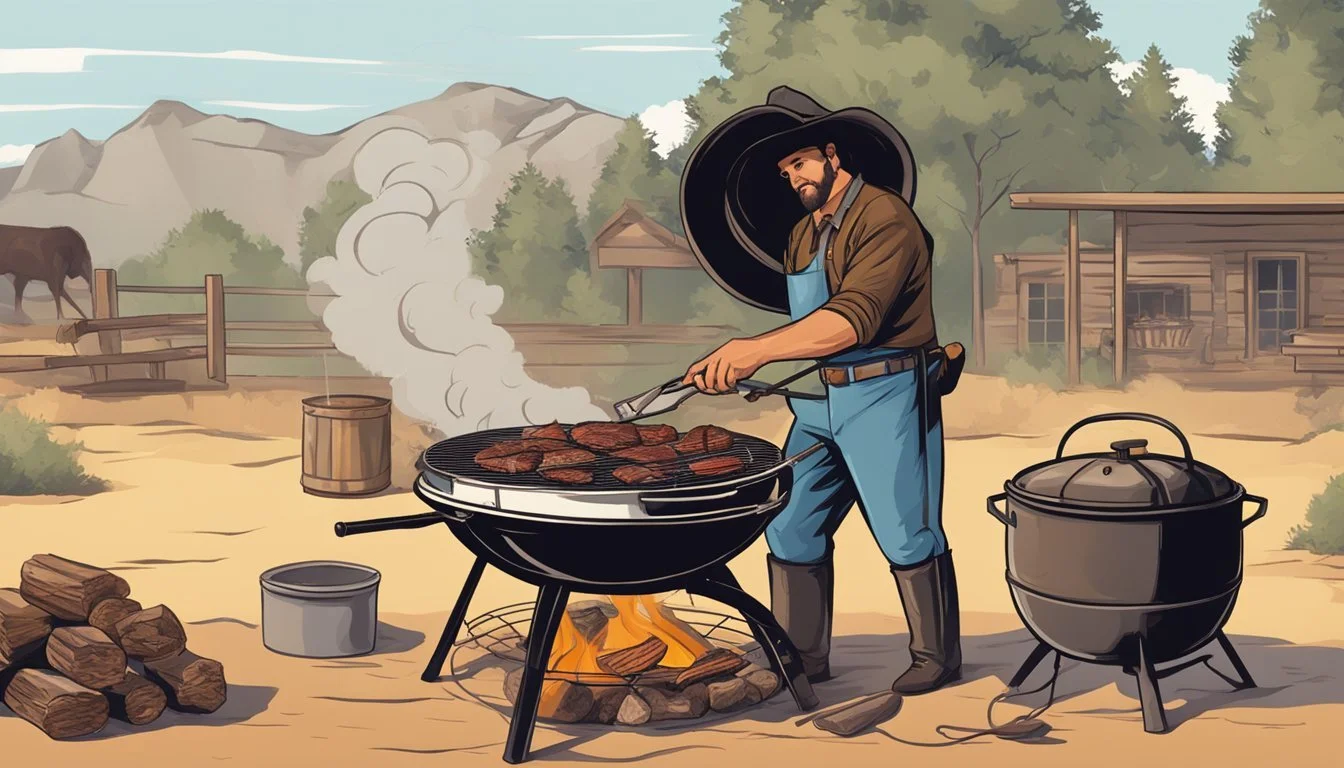The Texas Cowboy's Techniques for Grilling Over an Open Flame
Mastering the Art of Charcoal Cooking
In the heart of Texas, where cowboy culture is woven into the very fabric of its heritage, the art of grilling over an open flame burns as a steadfast tradition. These techniques, passed down through generations, have been honed under the expansive Texan sky, where cowboys have developed a reputation for turning simple cuts of meat into tender, flavorful feasts. Grilling over an open flame is not just about cooking; it encapsulates a longstanding cultural practice that reflects the robust spirit of Texas.
The cowboy method utilizes direct heat from mesquite wood fires to infuse the meat with a distinctive smoky flavor that is the hallmark of authentic Texas barbecue. The types of meat often associated with this traditional style of cooking range from beef, pivotal to the state's identity, to less conventional choices like goat and mutton. This practice invites a communal experience, echoing the camaraderie of ranch cookouts, and remains an essential aspect of Texan cuisine.
Adopting the cowboy's techniques requires an understanding of the wood's influence on flavor, the importance of even heat distribution, and the careful selection of meats suited for this rustic culinary approach. Grilling over an open flame demands a mastery that balances patience with precision, ensuring that each meal honors the cowboy's legacy. This rugged cooking method is a testament to Texas' rich history, a craft that embodies the character and resilience of those who have practiced it for decades.
History of the Texas Cowboy
The Texas cowboy emerged as a symbol of the American West, influenced by Spanish, Mexican, and Native American herding techniques. This section unveils their origins and how their legacy was cemented by figures like Charles Goodnight.
Origins and Cattle Drives
The vaqueros, skilled horsemen from Mexico, were the forerunners to the Texas cowboys. They introduced key cattle herding skills during the Spanish colonial period. In the 19th century, driven by the demand for beef in the East and the abundance of wild longhorn cattle in Texas, cowboys played a crucial role in cattle drives. Texas became the staging ground for moving millions of cattle north to railheads in Kansas, following the Civil War.
Key Skills: Herding, roping, and horsemanship
Cattle: Predominantly longhorn cattle, rugged and suited to the Texas climate
Routes: Famous drives included the Chisholm Trail and Goodnight-Loving Trail
Charles Goodnight and the Cowboy Legacy
Charles Goodnight, a legendary rancher, and trailblazer in the Texas Panhandle, co-founded the Goodnight-Loving Trail. Post-Civil War, his innovations in ranching and cattle driving, such as the invention of the chuckwagon, marked a turning point in cowboy life and the cattle industry.
Innovations: The chuckwagon for feeding cowboys during drives
Ranch: Goodnight’s JA Ranch became one of the largest in the Texas Panhandle
Influence: A key figure in transforming cowboy culture from a transient job into a professional occupation
Goodnight's legacy continues to influence the image of the Texas cowboy as a steward of the American frontier, with deep ties to the land and cattle they manage.
Traditional Cowboy Attire
When one envisions a Texas cowboy, certain iconic elements of their attire immediately come to mind. Integral to cowboy culture, traditional dress is as functional as it is emblematic of a storied way of life.
The Significance of Dress
Cowboy Hats: A staple of traditional cowboy attire, the cowboy hat is more than just a fashion statement—it serves to shield a cowboy's face from the harsh Texas sun and inclement weather. In Texas, the cowboy hat also carries a sense of state pride and is considered a symbol of authenticity within cowboy culture.
Boots: Designed to protect their feet while riding and working, cowboy boots feature a high top that guards the lower leg against scrapes and snake bites. The pointed toe helps a cowboy easily slip into the stirrup, and the heel prevents the foot from slipping through, ensuring safety.
Bandanas: These serve multiple functional purposes: protecting the cowboy's neck from sunburn, serving as a mask to filter out dust, and providing a handy cloth for wiping sweat.
Chaps: Pronounced "shaps," these sturdy coverings are worn over jeans to protect the cowboy's legs from the rough brush and cacti of the Texas landscape.
Gloves: A pair of gloves is essential for handling rough equipment, such as ropes and branding irons, which could otherwise cause blisters or burns on the hands.
Each component of a cowboy's attire has a specific purpose, reflecting the practical needs of daily life on the range while contributing to the iconic image of the Texas cowboy that is recognized worldwide.
Essentials of Open Flame Cooking
Grilling over an open flame requires a mastery of certain critical elements, including the selection of fuel and the management of heat. These are foundational to achieving the desired culinary results that are characteristic of traditional Texas cowboy cooking techniques.
Selecting the Right Wood and Charcoal
For authentic open flame cooking, the choice of wood plays a pivotal role in infusing flavor. Hardwoods such as oak, mesquite, and hickory are preferred for their long burn times and distinctive smoky notes they impart to the food. When wood isn't available or for more control, charcoal—especially lump charcoal—stands as a reliable alternative. It offers consistent heat and can be easily supplemented with wood chips for extra flavor.
Wood or Charcoal Burn Time Flavor Profile Oak Long Mild, Versatile Mesquite Long Strong, Earthy Hickory Long Sweet, Smoky Lump Charcoal Medium to Long Neutral
Temperature Control and Cooking Methods
Managing the temperature is essential for successful open flame cooking. Cooks must cultivate the skill of creating temperature zones on the grill: a high heat area for searing meats, and a medium heat zone for slower cooking and smoking. The temperature can be regulated by the distribution of coals or woods, and by adjusting the distance between the food and the flames. The cooking method often depends on the type of food being prepared; for example, a sizable cut of meat requires indirect heat to cook thoroughly without burning, while vegetables might be grilled over medium-high heat directly above the flame.
Direct Grilling: Food is placed directly over the flame for quick cooking at high heat. Ideal for steaks, burgers, and kebabs.
Indirect Grilling: Food is placed away from the direct heat source, allowing it to cook slowly and evenly. Good for larger cuts of meat.
Smoking: Using low heat and wood smoke to flavor and cook food over several hours, suitable for briskets and ribs.
In open flame cooking, precise control and the judicious use of both wood and charcoal are paramount for the Texas cowboy over the campfire or modern griller seeking that rustic culinary experience.
Classic Cowboy Grilling Techniques
When one discusses classic cowboy grilling techniques, they are usually referring to methods that have been honed over the open flames of campfires, harnessing the rich flavors of wood smoke and simple yet robust seasonings. Cowboys of yesteryear favored practicality and the deeply satisfying taste that comes with flame-cooked meat.
Meat Selection and Preparation
Selecting the right cut of meat is paramount. Texas cowboys often opt for beef, such as a thick, marbled ribeye steak (What wine goes well with ribeye steak?) or cuts of goat and mutton. The meat should be brought to room temperature before grilling, as this helps in ensuring even cooking. Before it hits the grill, it's not uncommon for the meat to be seasoned simply with salt and pepper to enhance the natural flavors and help form a crisp crust over the heat.
Step for Preparation:
Choose a meat cut with the right level of fat – ideally, a ribeye with good marbling.
Season simply with salt and pepper or a traditional dry rub of spices.
Allow meat to rest at room temperature before cooking.
Consider using a marinade for tougher cuts to tenderize them.
Using a Dutch Oven Outdoors
The Dutch oven is a staple of cowboy cooking. Versatile and durable, it allows for a variety of dishes to be prepared over an open flame, from stews and chilis to bread and desserts. The heavy cast-iron construction retains heat superbly, enabling consistent cooking temperatures. It's important to preheat the Dutch oven before adding ingredients, and to manage the embers carefully to cook the food thoroughly without burning it.
Key Points for Dutch Oven Usage:
Preheat the Dutch oven to reach a uniform temperature.
Adjust the number of embers on top and beneath to regulate heat.
Use the Dutch oven lid to trap heat and flavors during cooking.
Through these techniques, the essence of cowboy cooking is captured, offering a nod to tradition while delivering deeply flavorful meals.
Iconic Texas Cowboy Dishes
The culinary traditions of Texas cowboys are reflected in robust, flavorful dishes designed to satisfy a hard-working crew. These recipes have been refined over generations and are characterized by their use of local ingredients, such as beef and game, coupled with cooking methods perfect for the great outdoors.
Recipes for Beef and Game
Texas cowboys are known for their mastery in barbecuing beef and game over open flames. Key ingredients such as brisket and venison (What wine goes well with venison?) are prepared using a variety of techniques, including slow-cooking and smoking to impart a deep, savory flavor.
Brisket: A staple at any cowboy gathering, brisket is seasoned with a simple yet powerful blend of chili powder, cumin, salt, and pepper, then smoked over mesquite until tender.
Venison: Often obtained during hunting expeditions, venison is marinated in robust spices before grilling, ensuring a flavorful result that highlights the game's natural richness.
Cowboy Beans and Side Dishes
Cowboy beans serve as a hearty complement to any cowboy meal, combining pinto beans with ingredients like corn, bacon, and brown sugar to create a sweet and savory flavor experience.
Cowboy Beans: Pinto beans are slow-cooked in a cast-iron skillet with bacon, onions, and spices; a touch of brown sugar balances the smokiness.
Cornbread: Made in a Dutch oven, cornbread provides a perfect accompaniment to cowboy beans, ideal for sopping up the flavorful juices.
Desserts and Cowboy Coffee
Even on the range, cowboys had a penchant for sweets and a good cup of cowboy coffee. Following hearty meals, simple yet satisfying desserts were prepared, and coffee was brewed over the campfire.
Dutch Oven Peach Cobbler: With its bubbly, caramelized fruit and a golden-baked topping, this dessert is a favored treat at the end of a long day.
Cowboy Coffee: Brewed strong in a tin pot, it's heated until boiling, then allowed to settle before serving, providing a robust end to the meal.
Cowboys' Influence on Texan Cuisine
The Texas cowboy has left an indelible mark on the state's culinary landscape, blending the flavors and techniques from various cultures to produce a unique food identity centered around open-flame cooking.
Fusion of Cultures in Cowboy Cooking
Texan cuisine, deeply influenced by cowboy culture, is a melting pot of flavors where Mexican, Native American, and cowboy cookery techniques collide. The open pastures of the Lone Star State offered cowboys access to a variety of cattle, leading to an emphasis on beef dishes in the region's cuisine. Cowboys incorporated Mexican culinary staples such as beans, tomatoes, and chili peppers into their diet, adapting the use of these foods to the resources available on long cattle drives. The result of this culinary fusion is the distinct flavor profile of Texan dishes, with Tex-Mex cuisine as a notable example, which combines traditional Mexican dishes with cowboy influences.
Legacy in Modern Texas Fare
The legacy of cowboy cuisine can be seen in modern Texas fare, with many traditional dishes still celebrated today. A treasured Texan dish, chicken fried steak, represents the ingenuity of cowboy cooking, transforming a tough cut of meat into a tender, flavorful staple. Additionally, the cowboy tradition of cooking over an open flame has been preserved, with grilling remaining a popular method for preparing meats in Texas. The time-honored use of indigenous ingredients, like beans and chili peppers, continues to be foundational in Texan recipes, ensuring the cowboy's role in the culinary story of Texas endures.
Fostering Cowboy Traditions Today
Today's cowboy culture pays homage to the past by keeping traditional grilling techniques alive. Renewed interest in these methods and the community spirit associated with them breathes new life into the cowboy heritage.
The Role of Rodeos and Cook-offs
Rodeos and cook-offs play a pivotal role in celebrating cowboy traditions. These events serve as a platform where the art of grilling over an open flame is not only practiced but also competitively showcased. They underscore the continuous appreciation and dedication to the craft that was once essential for nourishment on long trail drives.
Rodeos: Encompassing more than just roping and riding, rodeos honor cowboy legacies including cattle herding and horsemanship from North America to Mexico.
Cook-offs: Events like chuckwagon competitions preserve historical cooking techniques, emphasizing the importance of flame-grilling and Dutch oven usage.
Preserving Techniques for Future Generations
Maintaining the integrity of cowboy grilling traditions relies on the commitment to teaching and sharing these techniques. Institutions and enthusiasts, drawing inspiration from figures like Oliver Loving, a trailblazing cattle rancher, create educational programs to ensure that future generations have a tangible connection to this part of their heritage.
Educational Programs: These often include hands-on workshops and mentoring by seasoned grill masters.
Cultural Events: Festivals and historical reenactments that involve open flame grilling help manifest the cowboy spirit for attendees of all ages.
By engaging in these practices and participating in events that celebrate cowboy culture, individuals and communities foster a deep respect for the traditions that have shaped the identity of the region.





